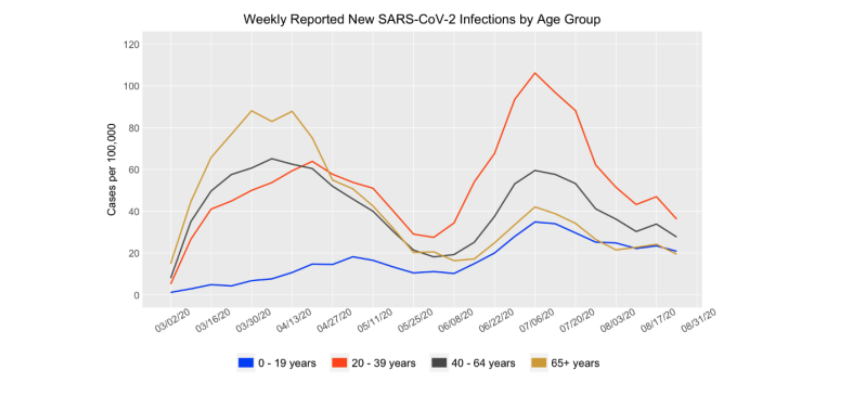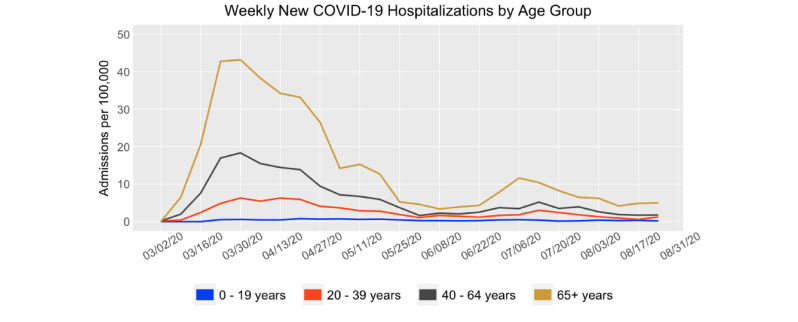DENVER – Though the number of people infected with the novel coronavirus remains “relatively low” in Colorado, state health officials warned Wednesday we could see a surge in cases within the next two months if only 65% of the population continues to practice proper social distancing.
The projection was part of new modeling data released by the Colorado Department of Public Health and Environment (CDPHE) and the Colorado School of Public Health, which also showed that while a surge in infections will also create a need for more hospital beds in the state, it is unlikely the number of infections will exceed hospital capacity.
The spread of SARS-CoV-2, the virus which causes COVID-19, was reduced for much of July and August, leading to a decrease in hospitalizations and infections, a summary of the report states. In recent weeks, however, the estimated effective reproductive number — an estimated number of the recent growth rate of infections — has increased throughout the state, leading to a leveling off in the decrease of hospitalizations, which currently appear to be at a plateau, according to the new data.

The estimated effective reproductive number, or Re, in Colorado, has increased from 0.79 on Aug. 24 to 1.08 as of Sept. 7, according to the new data. If the Re number is above 1, the number of infections is growing, with higher values indicating faster growth. But if the Re number is below 1, cases are declining, according to the COVID-19 modeling group, who prepared the newly released report.
State health officials noted in the report that Colorado’s adherence to proper social distancing guidelines has decreased an estimated 10% since the beginning of August.
From the week of Aug. 3-11, officials estimated 75% of the population was practicing proper social distancing. That number went down 2% by mid-August, and by the week ending on Aug. 25, only 65% of Coloradans were estimated to be practicing proper social distancing. Health officials were not able to provide more recent social distancing estimates due to a 13-day lag between infection and hospitalization rates, they said in the report.
Unsurprisingly, the new data also showed that young adults in the 20 to 39 age group account for the highest number of new coronavirus infections, with approximately 40 new cases per 100,000 people each week. Those in the 40-67 age group come in second, kids and teens come in third and seniors are at the bottom of the barrel with only about 20 new cases out of 100,000 reported each week, though they are still well above the other age groups when it comes to hospitalizations.


The report also reiterated that which has been known for quite some time now – that COVID-19 disproportionately affects people of color more so than whites. The new data showed Hispanics amounted for more than 40 new weekly cases of the coronavirus per 100,000 people, while whites accounted for less than 20 new cases per 100,000 people.
Possible scenarios if social distancing is relaxed
The report from the CDPHE and the Colorado School of Public Health not only projected a surge in cases if 65% of Coloradans maintain proper social distancing within the next months, they also projected how the state would fare if Polis were to relax current social distancing measures to between 50-55%.
Should the state relax those measures – with a starting date of Sept. 11 – Colorado would reach ICU capacity by January 30, 2021 and see an ICU demand peak less than a month after that with more than 1 million cases in Colorado and more than 4,500 deaths.
At 55% social distancing, the state would see ICU demand peaks by March 29, 2021 and nearly 720,000 infections with 3,400 deaths. At 60% social distancing, we would not reach ICU demand peaks until late June of next year and would have nearly half-a-million infections throughout the state with 2,700 dead.
Health officials noted in the report their projections and estimates were based on currently available data and their current understanding of the virus and how it spreads from person to person, and added that "the science on COVID-19 and the pandemic are evolving rapidly, and we regularly update our model assumptions as new information becomes available."
Current statewide estimates
The report estimates that approximately 294,000 people in Colorado – or 5% of the total population – has been infected with the novel coronavirus since cases began popping up in March, and they estimate that approximately 5,200 people – or 1 in every 1,100 Coloradans – are currently infected with the new respiratory disease.
Health officials also said nearly half of infections (48%) were detected within the past two weeks, including both asymptomatic and symptomatic infections.
As of this Wednesday, Colorado has reported more than 62,686 infections since the novel coronavirus was first reported in our state on March 5. A total of 1,905 people have died from the virus.



